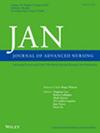Predicting Pressure Injury Prevention Education by Acute Care Nurses Within 24 h of Hospital Admission: A Cross-Sectional Study.
IF 3.4
3区 医学
Q1 NURSING
引用次数: 0
Abstract
AIM Predicting medical/surgical nurses' delivery of patient pressure injury prevention education within 24 h of hospitalisation. DESIGN A cross-sectional sub-study drawn from a larger multisite randomised controlled trial. METHODS A consecutive sub-sample of 300 randomly assigned control group participants was recruited from 20 medical and surgical wards at two major hospitals (July 2020 to August 2023) in Queensland, Australia. Semi-structured observations and chart audit data were collected, including patient education, demographic and clinical data. Binary logistic regression identified hospital site, clinical and patient predictors contributing to pressure injury prevention education delivery by nurses. RESULTS Seventeen (5.7%) participants received pressure injury prevention education within the first 24 h of admission. Body mass index was an independent predictor, increasing the odds of nurses delivering patient education. CONCLUSION Few episodes of pressure injury prevention education were observed in this study. As a patient's body mass index rises, they are more likely to receive preventative education from nurses soon after admission. IMPLICATIONS FOR PRACTICE AND POLICY Our findings underscore the need for standardised inclusive protocols and ongoing nurse training to assess and address education needs beyond single risk factors like body mass index. Further research should explore other factors influencing patient education delivery in hospitals. REPORTING METHOD This study adhered to STROBE guidelines. Dr. Brett Dyer, statistician, is part of the author team. PATIENT OR PUBLIC CONTRIBUTION No patient or public contribution.急性护理护士在入院24小时内预测压力伤害预防教育:一项横断面研究。
预测内科/外科护士在住院24小时内对患者进行压力伤害预防教育。设计一项从较大的多地点随机对照试验中抽取的横断面亚研究。方法从澳大利亚昆士兰州两家大医院(2020年7月至2023年8月)的20个内科和外科病房中随机抽取300名连续子样本作为对照组。收集半结构化观察和图表审计数据,包括患者教育、人口统计学和临床数据。二元logistic回归确定了医院地点、临床和患者预测因素对护士压力伤害预防教育的影响。结果17例(5.7%)患者在入院前24 h内接受了压力损伤预防教育。身体质量指数是一个独立的预测因子,增加了护士提供患者教育的几率。结论本研究中压力损伤预防教育的发生率较低。随着患者体重指数的上升,他们更有可能在入院后不久接受护士的预防教育。对实践和政策的启示您的研究结果强调需要标准化的包容性协议和持续的护士培训,以评估和解决身体质量指数等单一风险因素之外的教育需求。进一步研究应探讨影响医院患者教育实施的其他因素。报告方法:本研究遵循STROBE指南。统计学家布雷特·戴尔博士是作者团队的一员。病人或公众捐款:没有病人或公众捐款。
本文章由计算机程序翻译,如有差异,请以英文原文为准。
求助全文
约1分钟内获得全文
求助全文
来源期刊
CiteScore
6.40
自引率
7.90%
发文量
369
审稿时长
3 months
期刊介绍:
The Journal of Advanced Nursing (JAN) contributes to the advancement of evidence-based nursing, midwifery and healthcare by disseminating high quality research and scholarship of contemporary relevance and with potential to advance knowledge for practice, education, management or policy.
All JAN papers are required to have a sound scientific, evidential, theoretical or philosophical base and to be critical, questioning and scholarly in approach. As an international journal, JAN promotes diversity of research and scholarship in terms of culture, paradigm and healthcare context. For JAN’s worldwide readership, authors are expected to make clear the wider international relevance of their work and to demonstrate sensitivity to cultural considerations and differences.

 求助内容:
求助内容: 应助结果提醒方式:
应助结果提醒方式:


